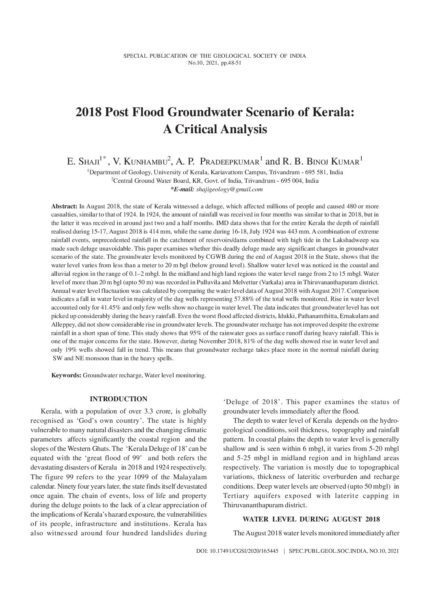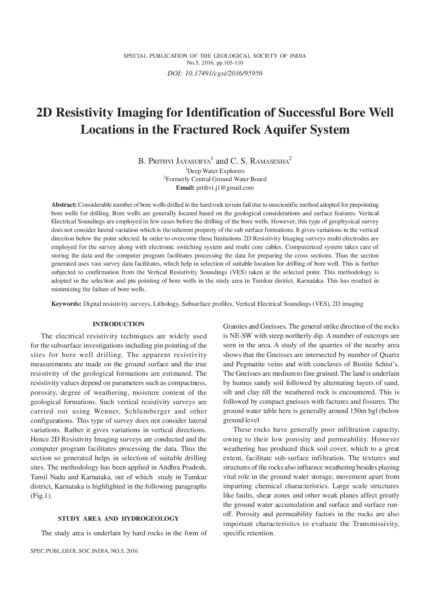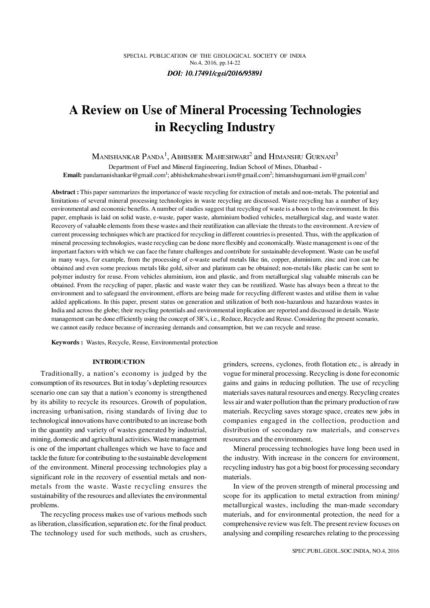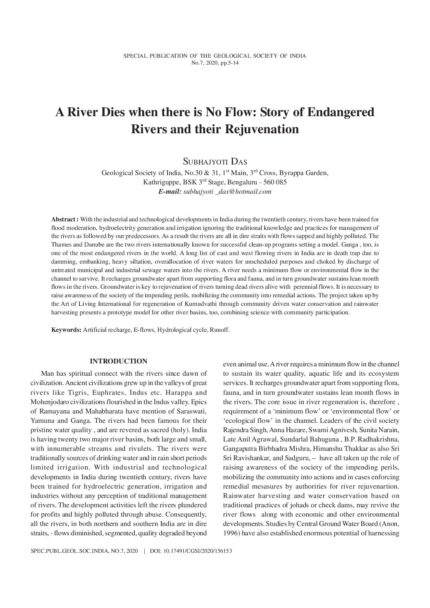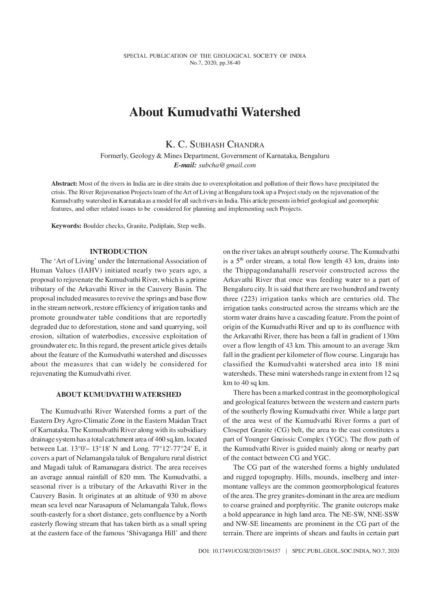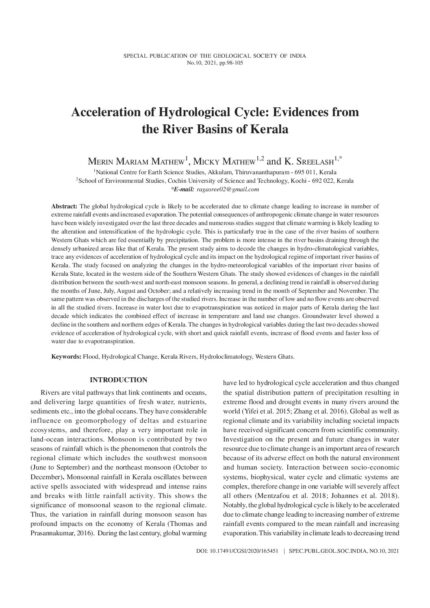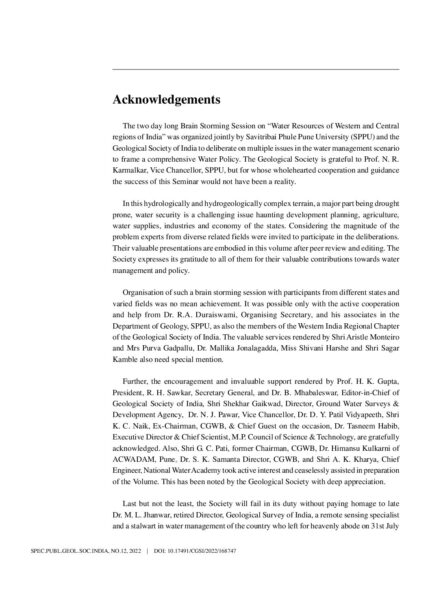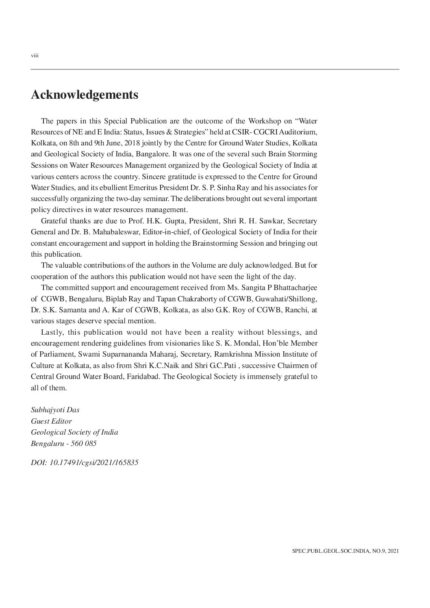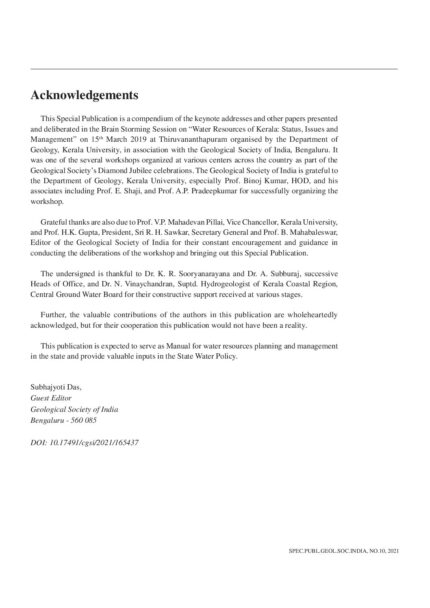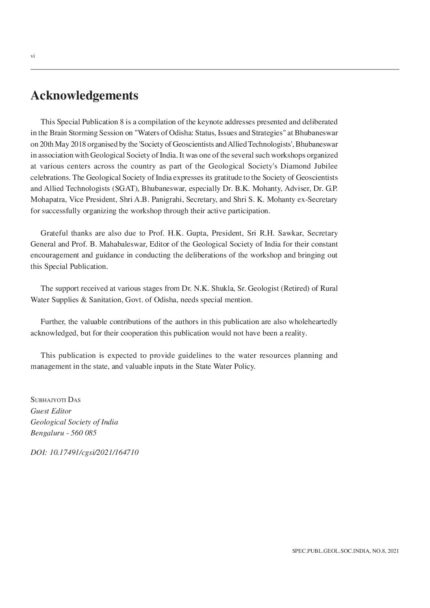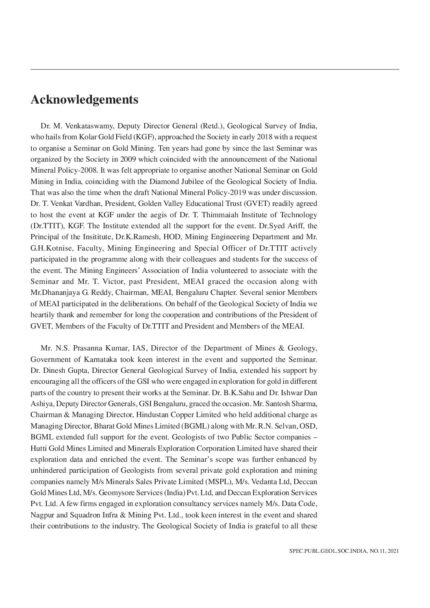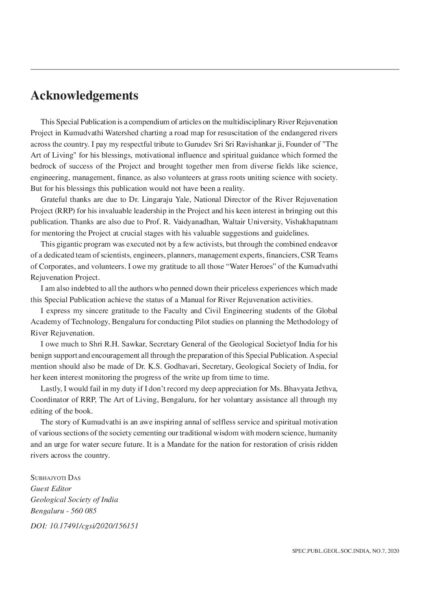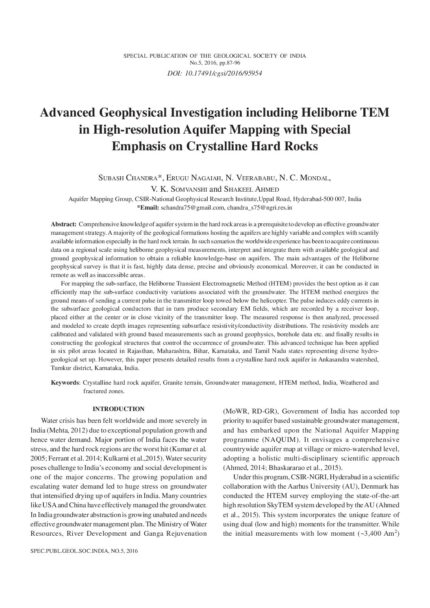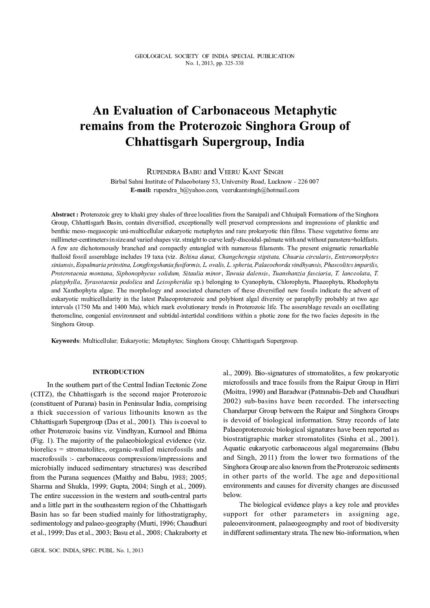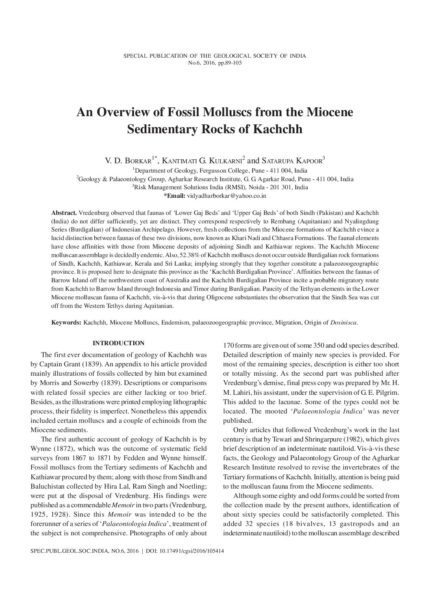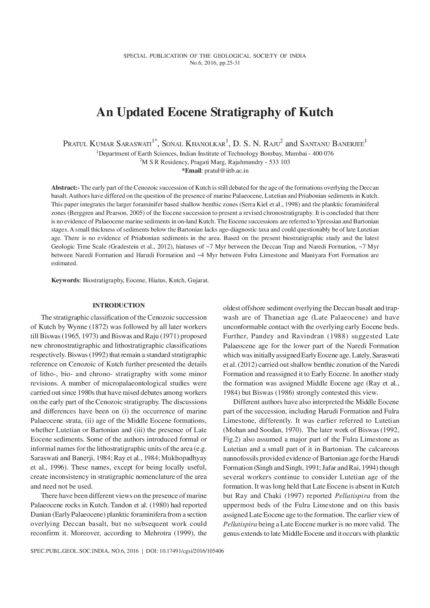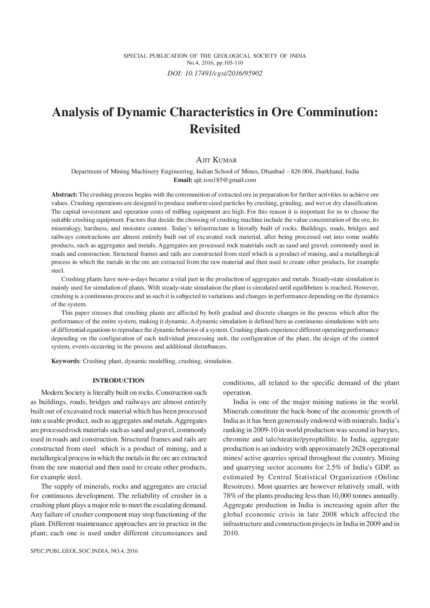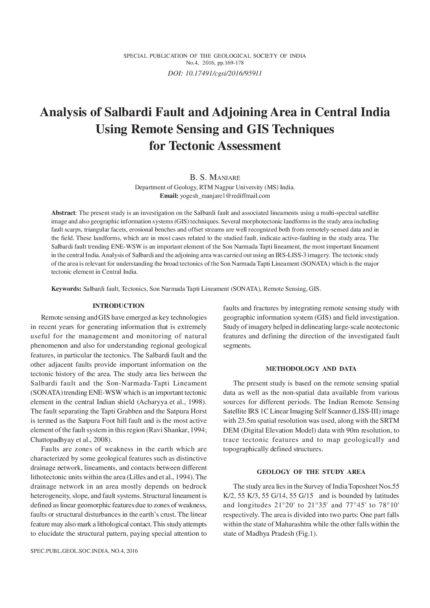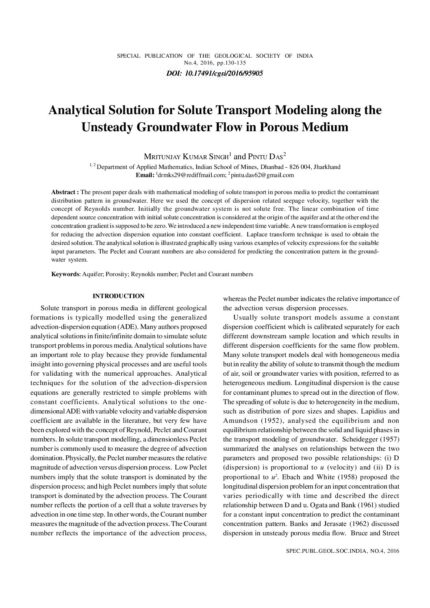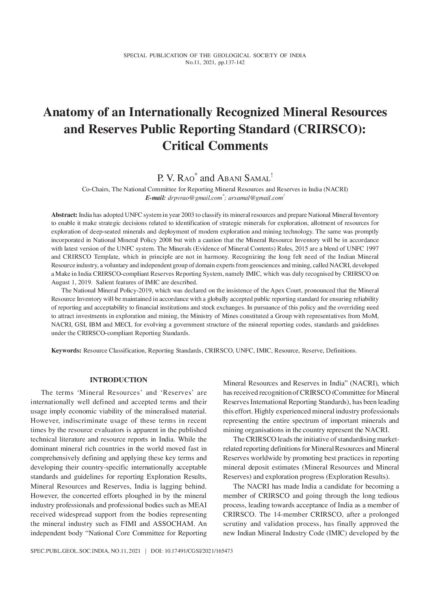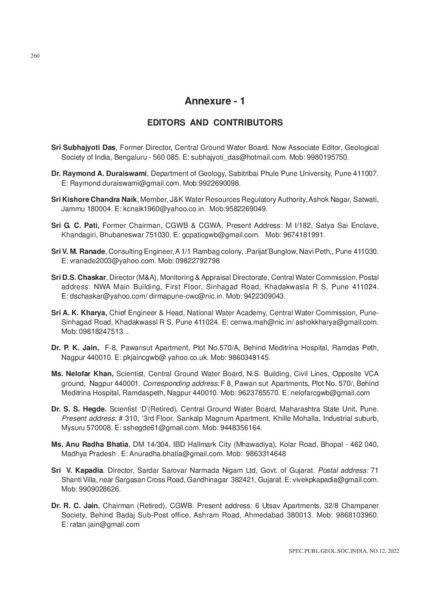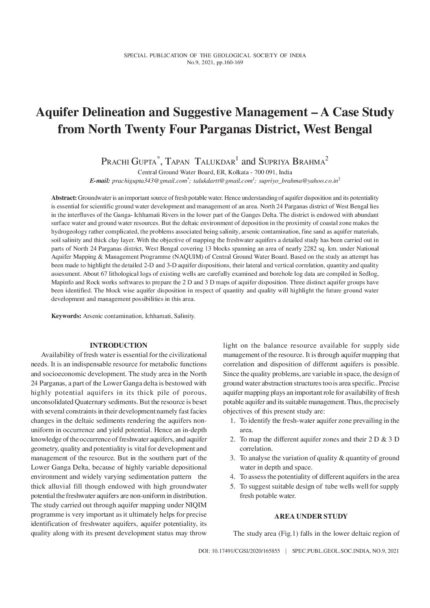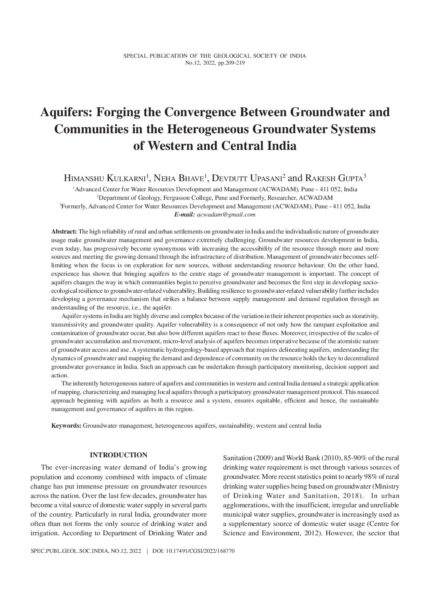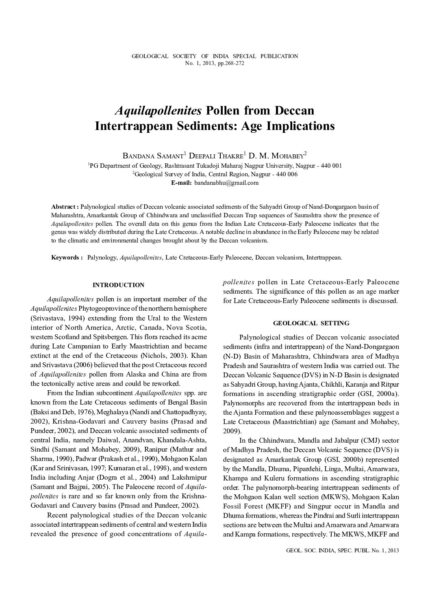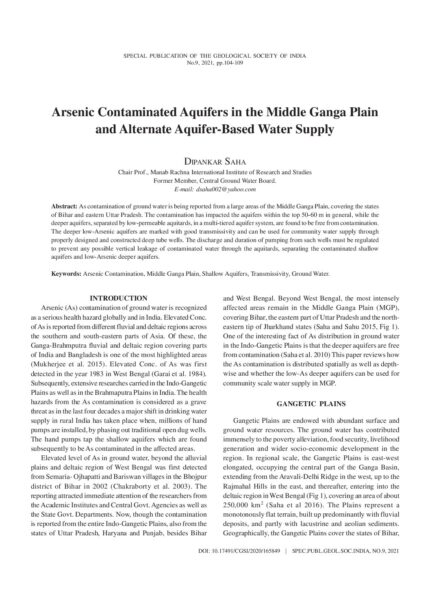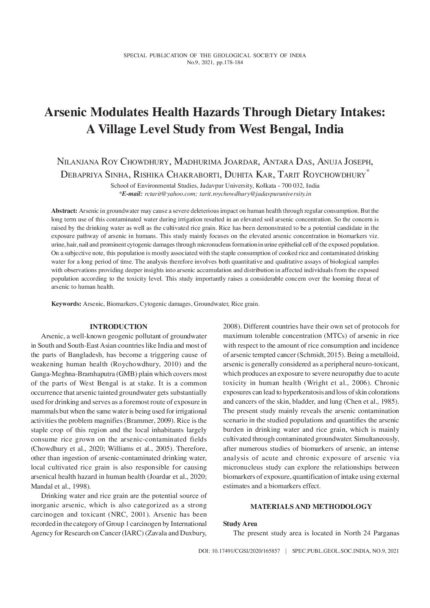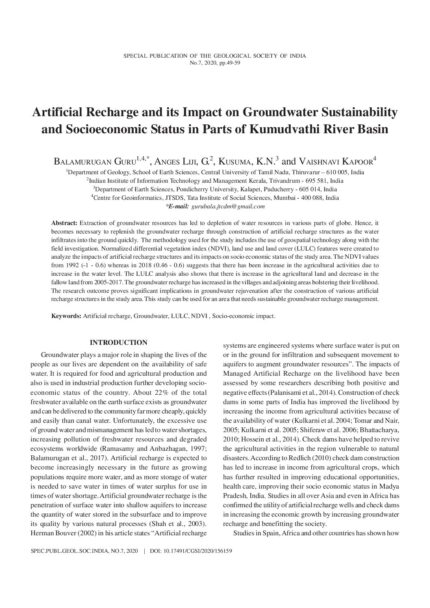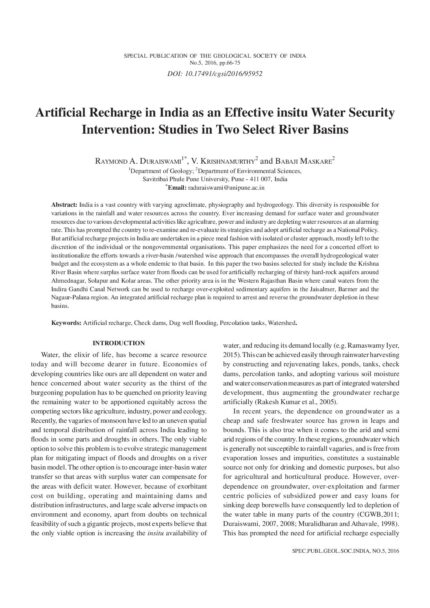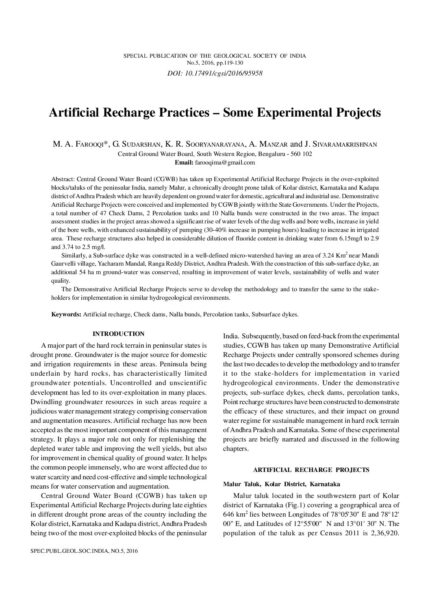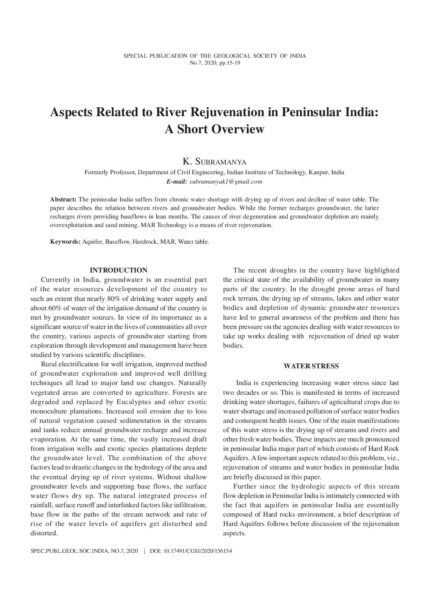Conference Papers
2018 Post Flood Groundwater Scenario of Kerala: A Critical Analysis
SKU:
C-165445
In August 2018, the state of Kerala witnessed a deluge, which affected millions of people and caused 480 or more casualties, similar to that of 1924. In 1924, the amount of rainfall was received in four months was similar to that in 2018, but in the latter it was received in around just two and a half months. IMD data shows that for the entire Kerala the depth of rainfall realised during 15-17, August 2018 is 414 mm, while the same during 16-18, July 1924 was 443 mm. A combination of extreme rainfall events, unprecedented rainfall in the catchment of reservoirs/dams combined with high tide in the Lakshadweep sea made such deluge unavoidable. This paper examines whether this deadly deluge made any significant changes in groundwater scenario of the state. The groundwater levels monitored by CGWB during the end of August 2018 in the State, shows that the water level varies from less than a meter to 20 m bgl (below ground level). Shallow water level was noticed in the coastal and alluvial region in the range of 0.1?2 mbgl. In the midland and high land regions the water level range from 2 to 15 mbgl. Water level of more than 20 m bgl (upto 50 m) was recorded in Pulluvila and Melvettur (Varkala) area in Thiruvananthapuram district. Annual water level fluctuation was calculated by comparing the water level data of August 2018 with August 2017. Comparison indicates a fall in water level in majority of the dug wells representing 57.88% of the total wells monitored. Rise in water level accounted only for 41.45% and only few wells show no change in water level. The data indicates that groundwater level has not picked up considerably during the heavy rainfall. Even the worst flood affected districts, Idukki, Pathanamthitta, Ernakulam and Alleppey, did not show considerable rise in groundwater levels. The groundwater recharge has not improved despite the extreme rainfall in a short span of time. This study shows that 95% of the rainwater goes as surface runoff during heavy rainfall. This is one of the major concerns for the state. However, during November 2018, 81% of the dug wells showed rise in water level and only 19% wells showed fall in trend. This means that groundwater recharge takes place more in the normal rainfall during SW and NE monsoon than in the heavy spells.
2D Resistivity Imaging for Identification of Successful Bore Well Locations in the Fractured Rock Aquifer System
SKU:
C-95956
Considerable number of bore wells drilled in the hard rock terrain fail due to unscientific method adopted for pinpointing bore wells for drilling. Bore wells are generally located based on the geological considerations and surface features. Vertical Electrical Soundings are employed in few cases before the drilling of the bore wells. However, this type of geophysical survey does not consider lateral variation which is the inherent property of the sub surface formations. It gives variations in the vertical direction below the point selected. In order to overcome these limitations 2D Resistivity Imaging surveys multi electrodes are employed for the survey along with electronic switching system and multi core cables. Computerized system takes care of storing the data and the computer program facilitates processing the data for preparing the cross sections. Thus the section generated uses vast survey data facilitates, which help in selection of suitable location for drilling of bore well. This is further subjected to confirmation from the Vertical Resistivity Soundings (VES) taken at the selected point. This methodology is adopted in the selection and pin pointing of bore wells in the study area in Tumkur district, Karnataka. This has resulted in minimizing the failure of bore wells.
A River Dies when there is No Flow: Story of Endangered Rivers and their Rejuvenation
SKU:
C-156153
With the industrial and technological developments in India during the twentieth century, rivers have been trained for flood moderation, hydroelectrity generation and irrigation ignoring the traditional knowledge and practices for management of the rivers as followed by our predecessors. As a result the rivers are all in dire straits with flows sapped and highly polluted. The Thames and Danube are the two rivers internationally known for successful clean-up programs setting a model. Ganga , too, is one of the most endangered rivers in the world. A long list of east and west flowing rivers in India are in death trap due to damming, embanking, heavy siltation, overallocation of river waters for unscheduled purposes and choked by discharge of untreated municipal and industrial sewage waters into the rivers. A river needs a minimum flow or environmental flow in the channel to survive. It recharges groundwater apart from supporting flora and fauna, and in turn groundwater sustains lean month flows in the rivers. Groundwater is key to rejuvenation of rivers turning dead rivers alive with perennial flows. It is necessary to raise awareness of the society of the impending perils, mobilizing the community into remedial actions. The project taken up by the Art of Living International for regeneration of Kumudvathi through community driven water conservation and rainwater harvesting presents a prototype model for other river basins, too, combining science with community participation.
Acceleration of Hydrological Cycle: Evidences from the River Basins of Kerala
SKU:
C-165451
The global hydrological cycle is likely to be accelerated due to climate change leading to increase in number of extreme rainfall events and increased evaporation. The potential consequences of anthropogenic climate change in water resources have been widely investigated over the last three decades and numerous studies suggest that climate warming is likely leading to the alteration and intensification of the hydrologic cycle. This is particularly true in the case of the river basins of southern Western Ghats which are fed essentially by precipitation. The problem is more intense in the river basins draining through the densely urbanized areas like that of Kerala. The present study aims to decode the changes in hydro-climatological variables, trace any evidences of acceleration of hydrological cycle and its impact on the hydrological regime of important river basins of Kerala. The study focused on analyzing the changes in the hydro-meteorological variables of the important river basins of Kerala State, located in the western side of the Southern Western Ghats. The study showed evidences of changes in the rainfall distribution between the south-west and north-east monsoon seasons. In general, a declining trend in rainfall is observed during the months of June, July, August and October; and a relatively increasing trend in the month of September and November. The same pattern was observed in the discharges of the studied rivers. Increase in the number of low and no flow events are observed in all the studied rivers. Increase in water lost due to evapotranspiration was noticed in major parts of Kerala during the last decade which indicates the combined effect of increase in temperature and land use changes. Groundwater level showed a decline in the southern and northern edges of Kerala. The changes in hydrological variables during the last two decades showed evidence of acceleration of hydrological cycle, with short and quick rainfall events, increase of flood events and faster loss of water due to evapotranspiration.
Advanced Geophysical Investigation including Heliborne TEM in High-Resolution Aquifer Mapping with Special Emphasis on Crystalline Hard Rocks
SKU:
C-95954
Comprehensive knowledge of aquifer system in the hard rock areas is a prerequisite to develop an effective groundwater management strategy. A majority of the geological formations hosting the aquifers are highly variable and complex with scantily available information especially in the hard rock terrain. In such scenarios the worldwide experience has been to acquire continuous data on a regional scale using heliborne geophysical measurements, interpret and integrate them with available geological and ground geophysical information to obtain a reliable knowledge-base on aquifers. The main advantages of the Heliborne geophysical survey is that it is fast, highly data dense, precise and obviously economical. Moreover, it can be conducted in remote as well as inaccessible areas. For mapping the sub-surface, the Heliborne Transient Electromagnetic Method (HTEM) provides the best option as it can efficiently map the sub-surface conductivity variations associated with the groundwater. The HTEM method energizes the ground means of sending a current pulse in the transmitter loop towed below the helicopter. The pulse induces eddy currents in the subsurface geological conductors that in turn produce secondary EM fields, which are recorded by a receiver loop, placed either at the center or in close vicinity of the transmitter loop. The measured response is then analyzed, processed and modeled to create depth images representing subsurface resistivity/conductivity distributions. The resistivity models are calibrated and validated with ground based measurements such as ground geophysics, borehole data etc. and finally results in constructing the geological structures that control the occurrence of groundwater. This advanced technique has been applied in six pilot areas located in Rajasthan, Maharashtra, Bihar, Karnataka, and Tamil Nadu states representing diverse hydrogeological set up. However, this paper presents detailed results from a crystalline hard rock aquifer in Ankasandra watershed, Tumkur district, Karnataka, India.
An Evaluation of Carbonaceous Metaphytic remains from the Proterozoic Singhora Group of Chhattisgarh Supergroup, India
SKU:
C-63405
Proterozoic grey to khaki grey shales of three localities from the Saraipali and Chhuipali Formations of the Singhora Group, Chhattisgarh Basin, contain diversified, exceptionally well preserved compressions and impressions of planktic and benthic meso-megascopic uni-multicellular eukaryotic metaphytes and rare prokaryotic thin films. These vegetative forms are millimeter-centimeters in size and varied shapes viz. straight to curve leafy-discoidal-palmate with and without parastem = holdfasts. A few are dichotomously branched and compactly entangled with numerous filaments. The present enigmatic remarkable thalloid fossil assemblage includes 19 taxa (viz. Beltina danai, Changchengia stipitata, Chuaria circularis, Enteromorphytes siniansis, Eopalmaria prinstina, Longfengshania fusiformis, L. ovalis, L. spheria, Palaeochorda vindhyansis, Phascolites imparilis, Proterotaenia montana, Siphonophycus solidum, Sitaulia minor, Tawuia dalensis, Tuanshanzia fasciaria, T. lanceolata, T. platyphylla, Tyrasotaenia podolica and Leiospheridia sp.) belonging to Cyanophyta, Chlorophyta, Phaeophyta, Rhodophyta and Xanthophyta algae. The morphology and associated characters of these diversified new fossils indicate the advent of eukaryotic multicellularity in the latest Palaeoproterozoic and polybiont algal diversity or paraphylly probably at two age intervals (1750 Ma and 1400 Ma), which mark evolutionary trends in Proterozoic life. The assemblage reveals an oscillating theromcline, congenial environment and subtidal-intertidal conditions within a photic zone for the two facies deposits in the Singhora Group.
An Overview of Fossil Molluscs from the Miocene Sedimentary Rocks of Kachchh
SKU:
C-105414
Vredenburg observed that faunas of 'Lower Gaj Beds' and 'Upper Gaj Beds' of both Sindh (Pakistan) and Kachchh (India) do not differ sufficiently, yet are distinct. They correspond respectively to Rembang (Aquitanian) and Nyalingdung Series (Burdigalian) of Indonesian Archipelago. However, fresh collections from the Miocene formations of Kachchh evince a lucid distinction between faunas of these two divisions, now known as Khari Nadi and Chhasra Formations. The faunal elements have close affinities with those from Miocene deposits of adjoining Sindh and Kathiawar regions. The Kachchh Miocene molluscan assemblage is decidedly endemic. Also, 52.38% of Kachchh molluscs do not occur outside Burdigalian rock formations of Sindh, Kachchh, Kathiawar, Kerala and Sri Lanka; implying strongly that they together constitute a palaeozoogeographic province. It is proposed here to designate this province as the 'Kachchh Burdigalian Province'. Affinities between the faunas of Barrow Island off the northwestern coast of Australia and the Kachchh Burdigalian Province incite a probable migratory route from Kachchh to Barrow Island through Indonesia and Timor during Burdigalian. Paucity of the Tethyan elements in the Lower Miocene molluscan fauna of Kachchh, vis-?-vis that during Oligocene substantiates the observation that the Sindh Sea was cut off from the Western Tethys during Aquitanian.
An Updated Eocene Stratigraphy of Kutch
SKU:
C-105406
The early part of the Cenozoic succession of Kutch is still debated for the age of the formations overlying the Deccan basalt. Authors have differed on the question of the presence of marine Palaeocene, Lutetian and Priabonian sediments in Kutch. This paper integrates the larger foraminifer based shallow benthic zones (Serra Kiel et al., 1998) and the planktic foraminiferal zones (Berggren and Pearson, 2005) of the Eocene succession to present a revised chronostratigraphy. It is concluded that there is no evidence of Palaeocene marine sediments in on-land Kutch. The Eocene successions are referred to Ypressian and Bartonian stages. A small thickness of sediments below the Bartonian lacks age-diagnostic taxa and could questionably be of late Lutetian age. There is no evidence of Priabonian sediments in the area. Based on the present biostratigraphic study and the latest Geologic Time Scale (Gradestein et al., 2012), hiatuses of ~7 Myr between the Deccan Trap and Naredi Formation, ~7 Myr between Naredi Formation and Harudi Formation and ~4 Myr between Fulra Limestone and Maniyara Fort Formation are estimated.
Analysis of Dynamic Characteristics in Ore Comminution:Revisited
SKU:
C-95902
The crushing process begins with the communition of extracted ore in preparation for further activities to achieve ore values. Crushing operations are designed to produce uniform sized particles by crushing, grinding, and wet or dry classification. The capital investment and operation costs of milling equipment are high. For this reason it is important for us to choose the suitable crushing equipment. Factors that decide the choosing of crushing machine include the value concentration of the ore, its mineralogy, hardness, and moisture content. Today's infrastructure is literally built of rocks. Buildings, roads, bridges and railways constructions are almost entirely built out of excavated rock material, after being processed out into some usable products, such as aggregates and metals. Aggregates are processed rock materials such as sand and gravel, commonly used in roads and construction. Structural frames and rails are constructed from steel which is a product of mining, and a metallurgical process in which the metals in the ore are extracted from the raw material and then used to create other products, for example steel.Crushing plants have now-a-days became a vital part in the production of aggregates and metals. Steady-state simulation is mainly used for simulation of plants. With steady-state simulation the plant is simulated until equilibrium is reached. However, crushing is a continuous process and as such it is subjected to variations and changes in performance depending on the dynamics of the system.This paper stresses that crushing plants are affected by both gradual and discrete changes in the process which alter the performance of the entire system, making it dynamic. A dynamic simulation is defined here as continuous simulations with sets of differential equations to reproduce the dynamic behavior of a system. Crushing plants experience different operating performance depending on the configuration of each individual processing unit, the configuration of the plant, the design of the control system, events occurring in the process and additional disturbances.
Analysis of Salbardi Fault and Adjoining Area in Central India Using Remote Sensing and GIS Techniques for Tectonic Assessment
SKU:
C-95911
The present study is an investigation on the Salbardi fault and associated lineaments using a multi-spectral satellite image and also geographic information systems (GIS) techniques. Several morphotectonic landforms in the study area including fault scarps, triangular facets, erosional benches and offset streams are well recognized both from remotely-sensed data and in the field. These landforms, which are in most cases related to the studied fault, indicate active-faulting in the study area. The Salbardi fault trending ENE-WSW is an important element of the Son Narmada Tapti lineament, the most important lineament in the central India. Analysis of Salbardi and the adjoining area was carried out using an IRS-LISS-3 imagery. The tectonic study of the area is relevant for understanding the broad tectonics of the Son Narmada Tapti Lineament (SONATA) which is the major tectonic element in Central India.
Analytical Solution for Solute Transport Modeling along the Unsteady Groundwater Flow in Porous Medium
SKU:
C-95905
The present paper deals with mathematical modeling of solute transport in porous media to predict the contaminant distribution pattern in groundwater. Here we used the concept of dispersion related seepage velocity, together with the concept of Reynolds number. Initially the groundwater system is not solute free. The linear combination of time dependent source concentration with initial solute concentration is considered at the origin of the aquifer and at the other end the concentration gradient is supposed to be zero. We introduced a new independent time variable. A new transformation is employed for reducing the advection dispersion equation into constant coefficient. Laplace transform technique is used to obtain the desired solution. The analytical solution is illustrated graphically using various examples of velocity expressions for the suitable input parameters. The Peclet and Courant numbers are also considered for predicting the concentration pattern in the groundwater system.
Anatomy of an Internationally Recognized Mineral Resources and Reserves Public Reporting Standard (CRIRSCO): Critical Comments
SKU:
C-165473
India has adopted UNFC system in year 2003 to classify its mineral resources and prepare National Mineral Inventory to enable it make strategic decisions related to identification of strategic minerals for exploration, allotment of resources for exploration of deep-seated minerals and deployment of modern exploration and mining technology. The same was promptly incorporated in National Mineral Policy 2008 but with a caution that the Mineral Resource Inventory will be in accordance with latest version of the UNFC system. The Minerals (Evidence of Mineral Contents) Rules, 2015 are a blend of UNFC 1997 and CRIRSCO Template, which in principle are not in harmony. Recognizing the long felt need of the Indian Mineral Resource industry, a voluntary and independent group of domain experts from geosciences and mining, called NACRI, developed a Make in India CRIRSCO-compliant Reserves Reporting System, namely IMIC, which was duly recognised by CRIRSCO on August 1, 2019. Salient features of IMIC are described.The National Mineral Policy-2019, which was declared on the insistence of the Apex Court, pronounced that the Mineral Resource Inventory will be maintained in accordance with a globally accepted public reporting standard for ensuring reliability of reporting and acceptability to financial institutions and stock exchanges. In pursuance of this policy and the overriding need to attract investments in exploration and mining, the Ministry of Mines constituted a Group with representatives from MoM, NACRI, GSI, IBM and MECL for evolving a government structure of the mineral reporting codes, standards and guidelines under the CRIRSCO-compliant Reporting Standards.
Aquifer Delineation and Suggestive Management ? A Case Study from North Twenty Four Parganas District, West Bengal
SKU:
C-165855
Groundwater is an important source of fresh potable water. Hence understanding of aquifer disposition and its potentiality is essential for scientific ground water development and management of an area. North 24 Parganas district of West Bengal lies in the interfluves of the Ganga- Ichhamati Rivers in the lower part of the Ganges Delta. The district is endowed with abundant surface water and ground water resources. But the deltaic environment of deposition in the proximity of coastal zone makes the hydrogeology rather complicated, the problems associated being salinity, arsenic contamination, fine sand as aquifer materials, soil salinity and thick clay layer. With the objective of mapping the freshwater aquifers a detailed study has been carried out in parts of North 24 Parganas district, West Bengal covering 13 blocks spanning an area of nearly 2282 sq. km. under National Aquifer Mapping & Management Programme (NAQUIM) of Central Ground Water Board. Based on the study an attempt has been made to highlight the detailed 2-D and 3-D aquifer dispositions, their lateral and vertical correlation, quantity and quality assessment. About 67 lithological logs of existing wells are carefully examined and borehole log data are compiled in Sedlog, Mapinfo and Rock works softwares to prepare the 2 D and 3 D maps of aquifer disposition. Three distinct aquifer groups have been identified. The block wise aquifer disposition in respect of quantity and quality will highlight the future ground water development and management possibilities in this area.
Aquifers: Forging the Convergence Between Groundwater and Communities in the Heterogeneous Groundwater Systems of Western and Central India
Conference Papers, SP-12: Water Resources of Western and Central Regions of India: Status, Issues and Strategies
SKU:
C-168770
The high reliability of rural and urban settlements on groundwater in India and the individualistic nature of groundwater usage make groundwater management and governance extremely challenging. Groundwater resources development in India, even today, has progressively become synonymous with increasing the accessibility of the resource through more and more sources and meeting the growing demand through the infrastructure of distribution. Management of groundwater becomes selflimiting when the focus is on exploration for new sources, without understanding resource behaviour. On the other hand, experience has shown that bringing aquifers to the centre stage of groundwater management is important. The concept of aquifers changes the way in which communities begin to perceive groundwater and becomes the first step in developing socioecological resilience to groundwater-related vulnerability. Building resilience to groundwater-related vulnerability further includes developing a governance mechanism that strikes a balance between supply management and demand regulation through an understanding of the resource, i.e., the aquifer.Aquifer systems in India are highly diverse and complex because of the variation in their inherent properties such as storativity, transmissivity and groundwater quality. Aquifer vulnerability is a consequence of not only how the rampant exploitation and contamination of groundwater occur, but also how different aquifers react to these fluxes. Moreover, irrespective of the scales of groundwater accumulation and movement, micro-level analysis of aquifers becomes imperative because of the atomistic nature of groundwater access and use. A systematic hydrogeology-based approach that requires delineating aquifers, understanding the dynamics of groundwater and mapping the demand and dependence of community on the resource holds the key to decentralized groundwater governance in India. Such an approach can be undertaken through participatory monitoring, decision support and action.The inherently heterogeneous nature of aquifers and communities in western and central India demand a strategic application of mapping, characterizing and managing local aquifers through a participatory groundwater management protocol. This nuanced approach beginning with aquifers as both a resource and a system, ensures equitable, efficient and hence, the sustainable management and governance of aquifers in this region.
Aquilapollenites Pollen from Deccan Intertrappean Sediments: Age Implications
SKU:
C-63312
Palynological studies of Deccan volcanic associated sediments of the Sahyadri Group of Nand-Dongargaon basin of Maharashtra, Amarkantak Group of Chhindwara and unclassified Deccan Trap sequences of Saurashtra show the presence of Aquilapollenites pollen. The overall data on this genus from the Indian Late Cretaceous-Early Paleocene indicates that the genus was widely distributed during the Late Cretaceous. A notable decline in abundance in the Early Paleocene may be related to the climatic and environmental changes brought about by the Deccan volcanism.
Arsenic Contaminated Aquifers in the Middle Ganga Plain and Alternate Aquifer-Based Water Supply
SKU:
C-165849
As contamination of ground water is being reported from a large areas of the Middle Ganga Plain, covering the states of Bihar and eastern Uttar Pradesh. The contamination has impacted the aquifers within the top 50-60 m in general, while the deeper aquifers, separated by low-permeable aquitards, in a multi-tiered aquifer system, are found to be free from contamination. The deeper low-Arsenic aquifers are marked with good transmissivity and can be used for community water supply through properly designed and constructed deep tube wells. The discharge and duration of pumping from such wells must be regulated to prevent any possible vertical leakage of contaminated water through the aquitards, separating the contaminated shallow aquifers and low-Arsenic deeper aquifers.
Arsenic Modulates Health Hazards Through Dietary Intakes: A Village Level Study from West Bengal, India
SKU:
C-165857
Arsenic in groundwater may cause a severe deleterious impact on human health through regular consumption. But the long term use of this contaminated water during irrigation resulted in an elevated soil arsenic concentration. So the concern is raised by the drinking water as well as the cultivated rice grain. Rice has been demonstrated to be a potential candidate in the exposure pathway of arsenic in humans. This study mainly focuses on the elevated arsenic concentration in biomarkers viz. urine, hair, nail and prominent cytogenic damages through micronucleus formation in urine epithelial cell of the exposed population. On a subjective note, this population is mostly associated with the staple consumption of cooked rice and contaminated drinking water for a long period of time. The analysis therefore involves both quantitative and qualitative assays of biological samples with observations providing deeper insights into arsenic accumulation and distribution in affected individuals from the exposed population according to the toxicity level. This study importantly raises a considerable concern over the looming threat of arsenic to human health.
Artificial Recharge and its Impact on Groundwater Sustainability and Socioeconomic Status in Parts of Kumudvathi River Basin
SKU:
C-156159
Extraction of groundwater resources has led to depletion of water resources in various parts of globe. Hence, it becomes necessary to replenish the groundwater recharge through construction of artificial recharge structures as the water infiltrates into the ground quickly. The methodology used for the study includes the use of geospatial technology along with the field investigation. Normalized differential vegetation index (NDVI), land use and land cover (LULC) features were created to analyze the impacts of artificial recharge structures and its impacts on socio economic status of the study area. The NDVI values from 1992 (-1 - 0.6) whereas in 2018 (0.46 - 0.6) suggests that there has been increase in the agricultural activities due to increase in the water level. The LULC analysis also shows that there is increase in the agricultural land and decrease in the fallow land from 2005-2017. The groundwater recharge has increased in the villages and adjoining areas bolstering their livelihood. The research outcome proves significant implications in groundwater rejuvenation after the construction of various artificial recharge structures in the study area. This study can be used for an area that needs sustainable groundwater recharge management.
Artificial Recharge in India as an Effective insitu Water Security Intervention: Studies in Two Select River Basins
SKU:
C-95952
India is a vast country with varying agroclimate, physiography and hydrogeology. This diversity is responsible for variations in the rainfall and water resources across the country. Ever increasing demand for surface water and groundwater resources due to various developmental activities like agriculture, power and industry are depleting water resources at an alarming rate. This has prompted the country to re-examine and re-evaluate its strategies and adopt artificial recharge as a National Policy. But artificial recharge projects in India are undertaken in a piece meal fashion with isolated or cluster approach, mostly left to the discretion of the individual or the nongovernmental organisations. This paper emphasizes the need for a concerted effort to institutionalize the efforts towards a river-basin /watershed wise approach that encompasses the overall hydrogeological water budget and the ecosystem as a whole endemic to that basin. In this paper the two basins selected for study include the Krishna River Basin where surplus surface water from floods can be used for artificially recharging of thirsty hard-rock aquifers around Ahmednagar, Solapur and Kolar areas. The other priority area is in the Western Rajasthan Basin where canal waters from the Indira Gandhi Canal Network can be used to recharge over-exploited sedimentary aquifers in the Jaisalmer, Barmer and the Nagaur-Palana region. An integrated artificial recharge plan is required to arrest and reverse the groundwater depletion in these basins.
Aspects Related to River Rejuvenation in Peninsular India: A Short Overview
SKU:
C-156154
The peninsular India suffers from chronic water shortage with drying up of rivers and decline of water table. The paper describes the relation between rivers and groundwater bodies. While the former recharges groundwater, the latter recharges rivers providing baseflows in lean months. The causes of river degeneration and groundwater depletion are mainly overexploitation and sand mining. MAR Technology is a means of river rejuvenation.

